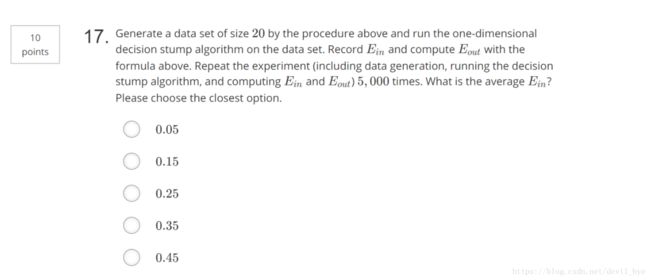台大林轩田《机器学习基石》:作业二python实现
台大林轩田《机器学习基石》:作业一python实现
台大林轩田《机器学习基石》:作业二python实现
台大林轩田《机器学习基石》:作业三python实现
台大林轩田《机器学习基石》:作业四python实现
完整代码:
https://github.com/xjwhhh/LearningML/tree/master/MLFoundation
欢迎follow和star
在学习和总结的过程中参考了不少别的博文,且自己的水平有限,如果有错,希望能指出,共同学习,共同进步
##17,18
分类方法是"positive and negative rays",老师上课讲过的
第17题是要在[-1,1]种取20个点,分隔为21个区间作为theta的取值区间,每种分类有42个hyphothesis,枚举所有可能情况找到使E_in最小的hyphothesis,记录最小E_in
第18题的意思是在17题得到的最佳hyphothesis的基础上,利用第16题的公式计算E_out.
注意点:
1.由16题得需要加20%噪声
2.使用16题的答案来计算E_out
代码如下:
import numpy as np
# generate input data with 20% flipping noise
def generate_input_data(time_seed):
np.random.seed(time_seed)
raw_X = np.sort(np.random.uniform(-1, 1, 20))
# 加20%噪声
noised_y = np.sign(raw_X) * np.where(np.random.random(raw_X.shape[0]) < 0.2, -1, 1)
return raw_X, noised_y
def calculate_Ein(x, y):
# calculate median of interval & negative infinite & positive infinite
thetas = np.array([float("-inf")] + [(x[i] + x[i + 1]) / 2 for i in range(0, x.shape[0] - 1)] + [float("inf")])
Ein = x.shape[0]
sign = 1
target_theta = 0.0
# positive and negative rays
for theta in thetas:
y_positive = np.where(x > theta, 1, -1)
y_negative = np.where(x < theta, 1, -1)
error_positive = sum(y_positive != y)
error_negative = sum(y_negative != y)
if error_positive > error_negative:
if Ein > error_negative:
Ein = error_negative
sign = -1
target_theta = theta
else:
if Ein > error_positive:
Ein = error_positive
sign = 1
target_theta = theta
# two corner cases
if target_theta == float("inf"):
target_theta = 1.0
if target_theta == float("-inf"):
target_theta = -1.0
return Ein, target_theta, sign
if __name__ == '__main__':
T = 5000
total_Ein = 0
sum_Eout = 0
for i in range(0, T):
x, y = generate_input_data(i)
curr_Ein, theta, sign = calculate_Ein(x, y)
total_Ein = total_Ein + curr_Ein
sum_Eout = sum_Eout + 0.5 + 0.3 * sign * (abs(theta) - 1)
# 17
print((total_Ein * 1.0) / (T * 20))
# 18
print((sum_Eout * 1.0) / T)
我的运行结果17题是0.17014,18题是0.2561434158451364
##19
下载训练样本,分别拿出每一维度分别按照16-18的方法计算其错误率,在每一维度选取各自最好的Hyphothesis。在得到的9个最好的Hyphothesis中,再选取这9个中最好的Hyphothesis,作为全局最优Hyphothesis,记录此时的Hyphothesis的参数,它所在的维度,最小错误率
实际上和16-18并无什么区别,只是注意要记得保存和比较
代码如下:
import numpy as np
def read_input_data(path):
x = []
y = []
for line in open(path).readlines():
items = line.strip().split(' ')
tmp_x = []
for i in range(0, len(items) - 1): tmp_x.append(float(items[i]))
x.append(tmp_x)
y.append(float(items[-1]))
return np.array(x), np.array(y)
def calculate_Ein(x, y):
# calculate median of interval & negative infinite & positive infinite
thetas = np.array([float("-inf")] + [(x[i] + x[i + 1]) / 2 for i in range(0, x.shape[0] - 1)] + [float("inf")])
Ein = x.shape[0]
sign = 1
target_theta = 0.0
# positive and negative rays
for theta in thetas:
y_positive = np.where(x > theta, 1, -1)
y_negative = np.where(x < theta, 1, -1)
error_positive = sum(y_positive != y)
error_negative = sum(y_negative != y)
if error_positive > error_negative:
if Ein > error_negative:
Ein = error_negative
sign = -1
target_theta = theta
else:
if Ein > error_positive:
Ein = error_positive
sign = 1
target_theta = theta
return Ein, target_theta, sign
if __name__ == '__main__':
# 19
x, y = read_input_data("hw2_train.dat")
# record optimal descision stump parameters
Ein = x.shape[0]
theta = 0
sign = 1
index = 0
# multi decision stump optimal process
for i in range(0, x.shape[1]):
input_x = x[:, i]
input_data = np.transpose(np.array([input_x, y]))
input_data = input_data[np.argsort(input_data[:, 0])]
curr_Ein, curr_theta, curr_sign = calculate_Ein(input_data[:, 0], input_data[:, 1])
if Ein > curr_Ein:
Ein = curr_Ein
theta = curr_theta
sign = curr_sign
index = i
print((Ein * 1.0) / x.shape[0])
运行结果为0.25
##20
对19题得到的最好的Hyphothesis,对测试数据集对应维度计算E_out
注意此时计算E_out是使用测试数据集,而不是16-18那样使用公式计算
代码如下,直接添加在19题的main方法里即可:
# 20
# test process
test_x, test_y = read_input_data("hw2_test.dat")
test_x = test_x[:, index]
predict_y = np.array([])
if sign == 1:
predict_y = np.where(test_x > theta, 1.0, -1.0)
else:
predict_y = np.where(test_x < theta, 1.0, -1.0)
Eout = sum(predict_y != test_y)
print((Eout * 1.0) / test_x.shape[0])
运行结果为0.355



